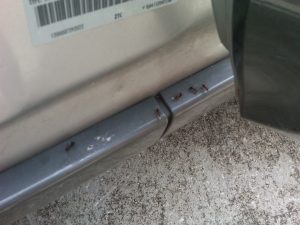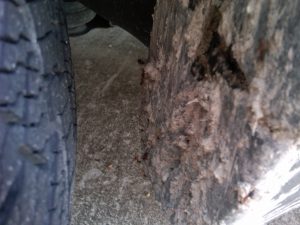An interesting observation I’ve had over the years about carpenter ants is that they tend to move nests sites quite a lot. Now if you’re looking for that little blue link where I send you to wiki ant encyclopedia or googles god of all pest control knowledge to back up my claim you might be disappointed. These are simply my observations and conclusions and I’d like to think I have some authority in this field after 25 years. Hey, did you click that link? You know you can’t trust the intranet nowadays, just stick with me, forget that guy.
Carpenter ants are like most ants, highly social but something a little unique with them is that they may have 5 to 7 nests in different locations but all one in the same colony. These separated sites are called satellite colonies and as any good exterminator knows it’s just as important to eliminate these as it is the ‘mother colony.’ Finding just one which your average Joe can do might put a hurting on the population and even disrupt operations a bit but it won’t be long before things get back to normal for the other 6. Finding two or more which is the sign of a real pro doesn’t happen as often due to property lines, physical barriers or lack of time and cost effectiveness.
Most often people encounter carpenter ant nests whether satellite or main colonies just by chance. It could be while
bringing in some firewood, doing some landscaping or repairing an old leak. This activity can expose them and you might find eggs, pupae, larvae and even winged reproductives. More often I would say (and this brings me to my point of mobile carpenter ants) people find the nests in places not so hospitable or traditional when we think of places this ant might choose to call home. To me, this suggests that they were on the move and this location was either meant to be temporary or they had recently just established. Spots like under a bucket in the driveway where just that weekend you had washed the car, a rug hung over a fence left to dry or even inside a car you parked under some trees for just one night. The list of examples goes on and on & I love to hear some of the odd ‘temporary’ spots you’ve found them in.I see this all the time and I know these spots can’t be anything permanent they would have chosen but there they are. Sometimes it’s only a few dozen but I’ve seen considerably more. You know it’s part of the colony because they have pupae stored with them and they guard them ferociously and even some with wings. The most recent episode of this I’ve seen was actually in my sons car. He had gone to a friends to spend the night and parked his car under some trees near their barn. The next day he drove across town to pick up his girlfriend and then back to our house. I don’t know what got them to suddenly come out after all that driving but pulling in the drive he was suddenly treated to about 200 carpenter ants all around his feet. The ants had to have moved in the night before and sure enough they had all the makings of a nice sized satellite colony pupae and all.
There are many reasons a nest might go on the move and seeking moisture would be on the top of any list. Perhaps the nest they were in suddenly had a lack of water or maybe was becoming to small. It may be they were forced out because their nest was destroyed by an animal or flooding but for whatever reason the evidence seems to point to a colony or faction thereof is on the move and to me it seems pretty common place. The only common denominator in these way points seems to be that most often it provides a moist place to wait out the day and when night time comes they can continue their search. Even with my son’s car they probably were attracted to the run off from the cars a/c and found refuge in the trim of the doors and fenders. Had it stayed parked I’d assume that the lack of h2o would have had them moving once again for a place with a more constant source.Well I’m not sure if I’ve made my case and like I said I don’t see a whole lot of Phd’s writing on the subject so for now you’ll just have to judge for yourself. In any case it’s a pretty amazing feat for this ant to move large numbers like this so quickly and the fact that I see this on such a regular basis indicates that carpenter ants are indeed, highly mobile.






